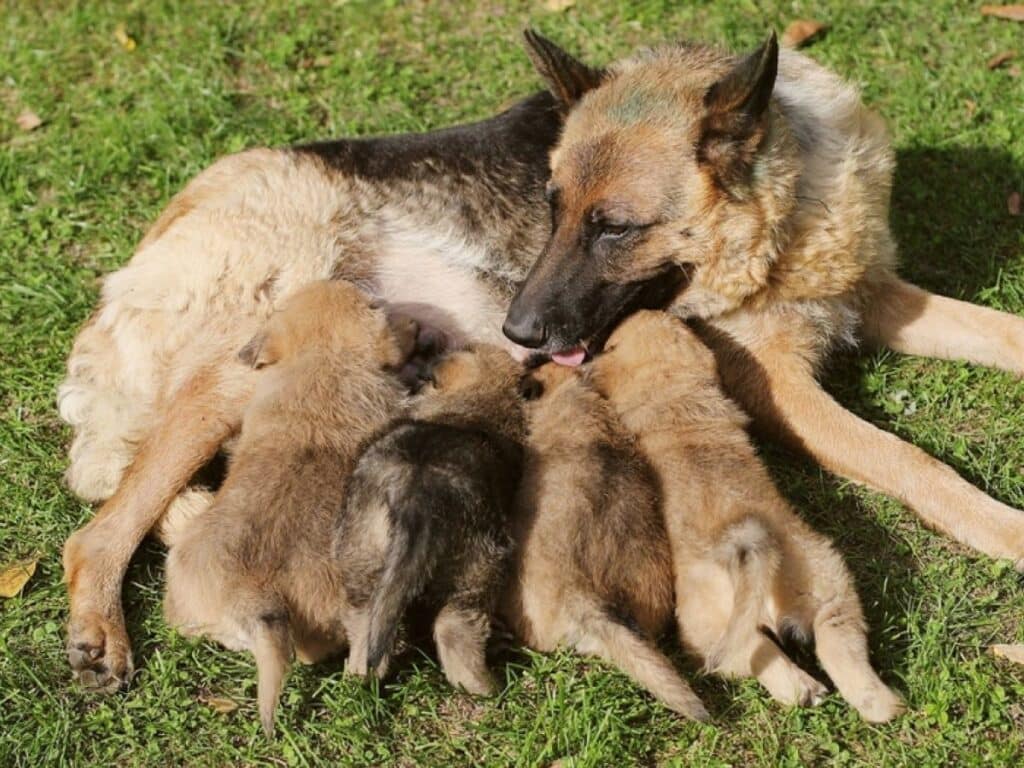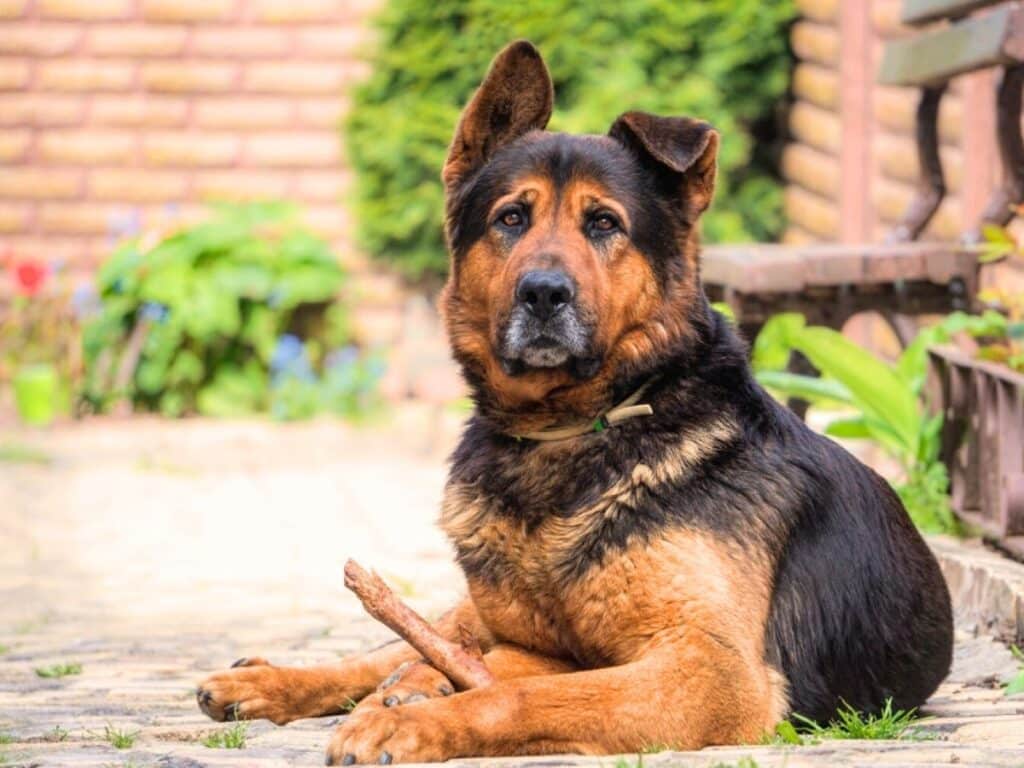Are you wondering “When will my German Shepherd stop growing?” Well, a long ago, I had the same question!
When my first German Shepherd, Todo, was approximately 6 weeks old, his limbs started to lengthen, giving him a somewhat disproportionate, but charmingly clumsy appearance.
I couldn’t help but wonder, “When will he grow into his body so he looks more proportionate?”
It took me several months to find out the answer to my question! But you don’t need to wait that long.
So without further ado, let me tell you “When does a GSD stop growing?”
When Do German Shepherds Stop Growing
German Shepherds typically reach their full height at around 18 to 24 months, while it may take them until they are 2 to 3 years old to fill out and reach their maximum weight. Female German Shepherds reach their full height by 12-14 months, and they reach their full weight by 1.5 to 2 years of age.
According to the American Kennel Club, males of the German Shepherd dog breed should be 24-26 inches tall and should weigh 65-90 pounds. Females, on the other hand, should be 22-24 inches tall weighing between 50-70 lbs.

Growth Phases of German Shepherds
Rapid Growth Rate During Puppyhood
From birth to around six months of age, German Shepherd puppies grow at an accelerated rate, gaining weight and height quite quickly.
- Birth to 3 Months: German Shepherd puppies grow quickly in size and weight. During this period, they develop motor skills and begin to explore their surroundings. Proper nutrition is crucial at this stage to support their rapid development.
- 3 to 6 Months: This is a period of continued rapid growth. Puppies will start to look more like miniature versions of their adult selves. Their rate of growth during these months is astonishing, and it’s not uncommon for them to gain weight quickly.
Throughout puppyhood, German Shepherds need to have a balanced diet rich in nutrients that cater to their developmental needs. Regular vet check-ups are essential to monitor their growth and overall health.
Slowing Growth Rate into Adulthood
As German Shepherds transition from puppyhood to adulthood, their growth rate gradually slows down. After reaching about six months of age, their bodies begin to mature at a slower pace compared to the initial months.
- 6 to 12 Months: During this period, growth starts to slow down. German Shepherds will continue to fill out in width and muscle, rather than just growing taller. This is also the time when they reach sexual maturity.
- 12 to 18 Months: By this age, most pups will have almost reached their full height. However, they may continue to fill out and gain muscle tone. It’s important to continue with good nutrition and regular exercise to ensure healthy development.
- 18 to 24 Months: At this stage, a German Shepherd is considered to have transitioned fully into adulthood. While most of their physical growth is complete, they may continue to develop in terms of muscle and coat condition.
German Shepherds generally reach their full height by 1.5 – 2 years of age but may continue to fill out and mature in muscle tone and size until they are about 2 -3 years old.
Regular exercise, consistent training, and a balanced diet are key to ensuring a healthy transition from puppyhood to a robust, adult German Shepherd.

German Shepherd Weight Chart
Below is a German Shepherd weight chart that I have created to help you get a rough estimate of your puppy’s average healthy weight at different stages of their life.
| Age | Male GSD Weight Range | Female GSD Weight Range |
| 1 Month | 5.5 – 9 lbs | 4.5 – 8 lbs |
| 2 Months | 16 – 20 lbs | 11 – 17 lbs |
| 3 Months | 22 – 30 lbs | 17 – 26 lbs |
| 4 Months | 35 – 40 lbs | 31 – 35 lbs |
| 5 Months | 40 – 49 lbs | 35 – 44 lbs |
| 6 Months | 49 – 57 lbs | 44 – 49 lbs |
| 7 Months | 57 – 62 lbs | 49 – 53 lbs |
| 8 Months | 62 – 66 lbs | 53 – 57 lbs |
| 9 Months | 64 – 71 lbs | 55 – 60 lbs |
| 10 Months | 66 – 73 lbs | 57 – 62 lbs |
| 11 Months | 71 – 75 lbs | 60 – 64 lbs |
| 12 Months | 71 – 79 lbs | 60 – 64 lbs |
| 1.5 Years | 71 – 79 lbs | 60 – 66 lbs |
| 2 Years | 71 – 84 lbs | 60 – 66 lbs |
| 3 Years | 79 – 88 lbs | 66 – 70 lbs |

German Shepherd Height Chart
Just like the weight chart above, you can refer to the below GSD height chart to understand when German Shepherds stop growing in height.
| Age | Male GSD Height Range | Female GSD Height Range |
| 1 Month | 4 – 6” | 3 – 6” |
| 2 Months | 7 – 9” | 6 – 9” |
| 3 Months | 9 – 11” | 8 – 10” |
| 4 Months | 11 – 14” | 10 – 12” |
| 5 Months | 14 – 16” | 12 – 14” |
| 6 Months | 16 – 18” | 15 – 17” |
| 7 Months | 19 – 20” | 17 – 19” |
| 8 Months | 20 – 22” | 18 – 20” |
| 9 Months | 21 – 23” | 19 – 21” |
| 10 Months | 22 – 24” | 19 – 21” |
| 11 Months | 22 – 24” | 20 – 22” |
| 12 Months | 22 – 24” | 20 – 22” |
| 1.5 Years | 23 – 25” | 21 – 22” |
| 2 Years | 23 – 23” | 21 – 22” |
| 3 Years | 24 – 26” | 22 – 24” |
To learn more about the height, weight, and other growth milestones of your German Shepherd pup at different stages of their life, check out my article German Shepherd Puppy Growth Chart.

How Big Will My German Shepherd Get
Adult male German Shepherds typically stand between 24 to 26 inches at the shoulder, while female GSDs range from 22 to 24 inches. The weight range is generally 65 to 90 pounds for males and 50 to 70 pounds for females.
If you’d like to know more precisely how big your German Shepherd puppy will get, there are a few tricks you could use to gauge a close-to-exact weight:
1. Consider the health and size of the parents
The size of the puppy’s parents can be a good indicator of its potential adult size.
Male German Shepherd puppies will likely take after their father’s size in adulthood, while female puppies will take after their mother’s size.
If both parents are within the breed standard, the puppy is likely to fall within a similar size range.
2. Look at their place in the litter
If they’re the runt in the litter, then there is a chance that they’ll remain small throughout adolescence and adulthood.
These runts often struggle in the earlier stages of life, as they cannot compete for the food and care they need from their mother.
The mother might also reject the runt instinctively as part of the process of natural selection.
However, keep in mind that it’s not unheard of for otherwise healthy runts to grow to the same size as their littermates.
3. Do some math
Although not foolproof, doing a bit of math based on your puppy’s weight at 20 weeks (4.5 months) old can help determine his adult weight.
Here’s the formula:
X pounds at 20 weeks ÷ 20 weeks = Y
Y × 52 weeks = Z
Divide their weight at 20 weeks by their current age in weeks and multiply by 52 weeks.
For example, let’s say your puppy weighs 40 pounds at 20 weeks.
You would calculate 40 pounds ÷ 20 weeks = 2.
Then, calculate 2 × 52 weeks = 104 pounds in adulthood.
Or, if your German Shepherd pup is 26 weeks (6 months) old or older, you can use a simpler formula:
Y pounds at 6 months old × 2 = Z total adult weight.
Let’s say your pup is 50 pounds at 6 months old.
50 × 2 = 100 pounds in adulthood!

How To Tell When Your German Shepherd Has Stopped Growing
A German Shepherd stops growing when it has reached physical maturity.
Physical maturity in German Shepherds is a gradual process that typically spans several months to a couple of years. Here are some signs indicating the attainment of physical maturity in German Shepherds:
Stable weight & proportionate size
Adult German Shepherds reach their full height and length, and their bodies exhibit a well-proportioned and balanced appearance.
The limbs, in particular, have reached their final length, and the dog no longer has the disproportionate look common in puppies.
Mature German Shepherds have achieved their full weight and muscle mass. This typically happens between the age of 2 -3 years.
Full coat
The coat of a mature German Shepherd is dense and weather-resistant, with longer guard hairs providing a protective outer layer. The coat is often thicker and more lustrous than during their puppy and adolescent stages.
Strong bone structure
The bones, particularly in the chest and shoulders, will be fully formed and will be broad. The body is solid and well-defined, reflecting the strength and athleticism characteristic of the breed.
Ears and tail
The ears of a mature German Shepherd are typically fully erect, especially if they are of the standard variety. The tail is bushy and reaches at least to the hock joint. The tail carriage is generally neutral when at rest, with a slight upward curve when the dog is alert.

Factors Influencing German Shepherd Growth
The growth of a German Shepherd is influenced by a variety of factors, including genetics, nutrition, health care, environmental conditions, and lifestyle. Here’s an overview of these factors:
Genetics
According to this research, the size, height, and overall build of a German Shepherd are largely determined by its genetic makeup. For example, if both parents are large and muscular, it’s likely that their offspring will also grow to be substantial in size.
Nutrition
A well-balanced diet rich in essential nutrients is crucial for proper bone development and muscle growth during the puppy stage. The right balance of protein, fats, vitamins, and minerals is essential for healthy growth.
RELATED: How Much To Feed a German Shepherd Puppy
Exercise
Regular exercise is vital for maintaining optimal health as well as supporting steady growth in young German Shepherds. Adequate physical activity ensures that they develop strong muscles while keeping excess weight at bay.
Environmental factors
The environment in which a German Shepherd is raised can impact its growth. Exposure to a clean and safe living space, appropriate temperature, and socialization opportunities contribute positively to a puppy’s development.
Stressful or unhealthy environments may impede growth and overall well-being.
Health care
Regular veterinary check-ups are essential to monitor the health and development of a German Shepherd. Vaccinations, parasite control, and preventive care contribute to overall well-being. Addressing health issues promptly can prevent complications that might hinder normal growth.
The longstanding belief that neutering or spaying dogs at an early age stunts their growth has been debunked by this latest research.
Closing Thoughts
Recognizing and supporting the growth stages of a German Shepherd is key to their overall well-being. By understanding when they stop growing and how to nurture their development, owners can ensure these beloved dogs thrive throughout their puppyhood into healthy, happy adulthood.




